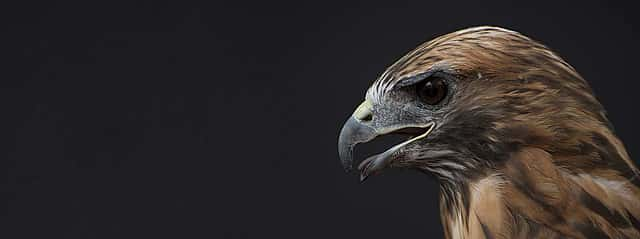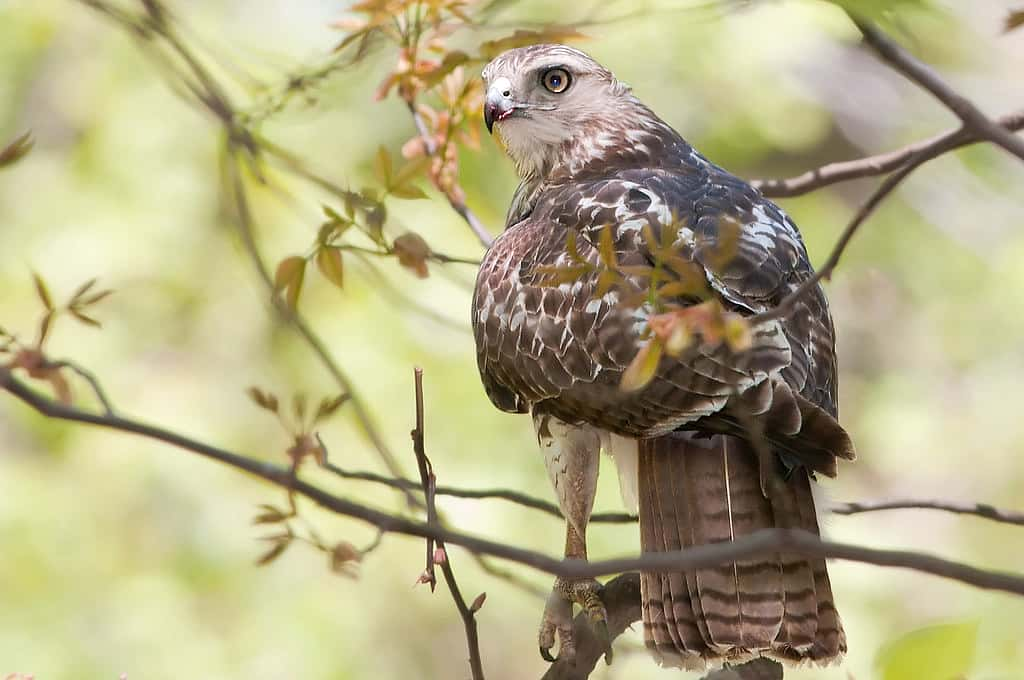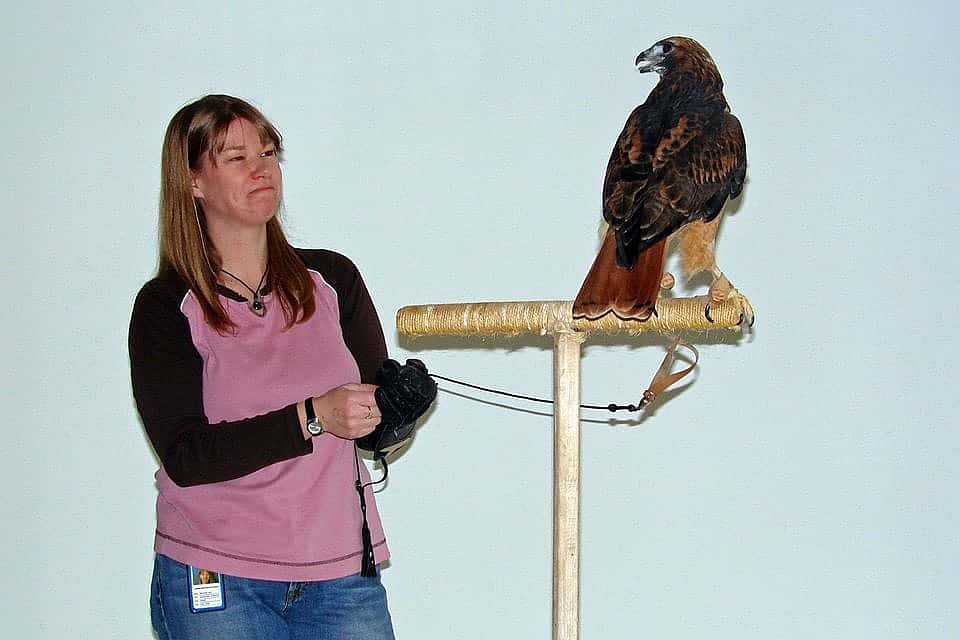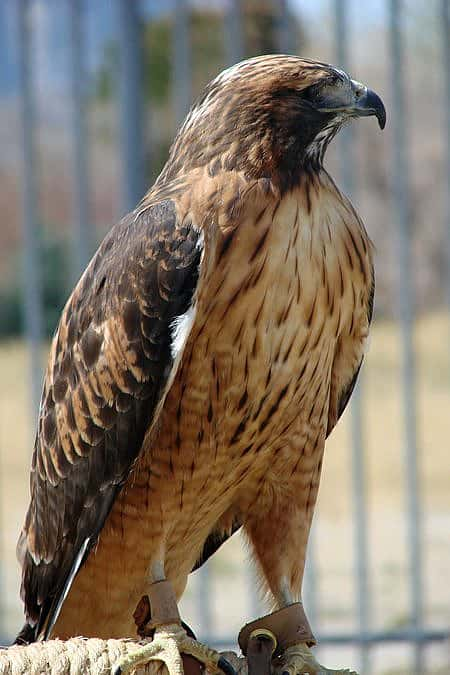
My Favorite Facts About the Red-tailed Hawk
When visitors first see Isham, our red-tailed hawk, often the first thing I hear is, “We have lots of these back home.” That is probably true, as red-tailed hawks are the most common soaring hawk in all of North America, from Alaska right down through Mexico and Central America, as well as in Jamaica. But do you know these interesting facts about red-tailed hawks? Below are five of my favorite facts.
1) The scream of a red-tailed hawk is majestic and thrilling to hear. So majestic, in fact, that movie makers years ago decided that their scream was much more befitting an eagle than the actual eagle call. Compared to a red-tail, eagle calls can sound a bit wimpy. So when you see that eagle in the movies, soaring through the sky, and hear that magnificent scream, you are actually hearing a sound-track of a red-tailed hawk. This is not only an interesting fact, but one that really irritates me, as I have even heard the red-tailed hawk scream accompanying an eagle on documentaries! How well are we being educated, if we think an eagle has a red-tail hawk scream? To hear the differences go to the following.”
Red-tailed Hawk compared to Bald Eagle
3) It is easy to identify a red-tailed hawk, since they have that beautiful rusty or brick-colored, red tail. Or is it? Did you know that the red-tailed hawk doesn’t get its red tail until sometime in their second year of life? And to complicate things further, some never get red tails. Along with the fact that these birds may vary in coloration from albino to almost black, identifying a perched red-tailed hawk can be more difficult than one would think. If the red tail isn’t visible, however, there is another way to identify it, provided you see the red-tailed hawk in flight. On the underside of the outstretched wings, you will usually see a distinctive dash-comma pattern on the leading edge.

3) I was surprised to learn that rattlesnake remains regularly show up in red-tailed hawks nests. The red-tailed hawk has developed a method to deal with this dangerous prey. It will land near the snake, and open both wings, sometimes fluttering one or both. This move will distract the attention of the snake to the open wings. If the snake should make a strike, it is more likely that the rattlesnake will go for the open wing feathers, rather than the body of the hawk. According to Dr. Charles Preston’s book Red-tailed Hawk, the hawk typically uses it’s talons to grab the snake in the middle of its body, then makes a quick bite to the head.
Check out this National Geographic Wild video of a red-tailed hawk and a rattlesnake:
4) I often see red-tailed hawks sitting on the top of power poles, where they perch, looking out across the landscape for prey. Like eagles, falcons, and other hawks, red-tailed hawks see in magnification, and with saturated color perception that is far superior to ours. Red-tails are capable of spotting a small mouse a mile away. A human may not notice a small brown mouse on a brownish rock, but to a red-tail who sees that mouse two to three times larger than we do, and whose color saturation gives him the ability to distinctly see the difference in the brown of the mouse and the brown of the rock, spotting the mouse is much easier.

5) Red-tailed hawks have spectacular courtship displays. These will begin in late winter, with both birds soaring in wide circles high above the ground. The male then begins a series of spectacular dives in view of the female. Eventually the male zooms to a position just above the female, and touches her with his legs extended. These behaviors may include repeated vocalizations. Courtship may also include the male capturing prey and offering it to the female. This courtship feeding is often done during the aerial displays with the female rolling over and extending her talons to accept the prey. In addition to these displays, both birds may also interlock talons, and spiral at great speeds toward the ground.
Question From Visitors:
I am sometimes asked this question as I hold Isham, our red-tailed hawk on my glove. Isham is missing his right eye, which had to be removed, due to a severe injury after being struck by a car.
Can birds survive in the wild with only one eye?
On rare occasions one-eyed birds have been found in the wild, and in some cases rehabilitators may return a one-eyed bird to the wild. However, a bird that is blind on one side, would only be returned to the wild if it was found injured, as an adult, and the veterinarian could determine from examining the bird that it had been living successfully in the wild with one eye before the injury had occurred. Normally, the survival rate of a one-eyed bird in the wild is very low. Raptors depend heavily on their sight when hunting, and a one eyed-bird would have no depth perception, reducing their ability to successfully make a kill. Also, being blind on one side gives predators that may be approaching the hawk from the blind side an advantage, as the bird may not see the predator unless it turned its head, and that may be too late.
Photos:
All photos except the immature Red-tailed Hawk are courtesy of the Draper Museum Raptor Experience.
Immature Red-tailed Hawk © Kelly Colgan Aza / Flickr, Attribution-NoDerivs 2.0 Generic Deed
Written By
Anne Hay
Anne Hay has a Bachelor's degree in Elementary Education and a Master's in Computers in Education. She spent most of her working years teaching third grade at Livingston School in Cody, Wyoming. After retiring she began doing a variety of volunteer work for the Buffalo Bill Center of the West’s Draper Natural History Museum. Anne loves nature and has a concern for the environment. She believes that educating the public, so that they will have a better understanding and appreciation for the natural world, is very important. Because of this belief, volunteering at the Center is a perfect fit. She spends time in the Draper Lab, observing eagle nests for Dr. Charles Preston’s long-term research project on nesting golden eagles, writing observation reports of raptor sightings in the Bighorn Basin, and working with the Draper Museum Raptor Experience. Anne states that, “Having a bird on my glove, is one of my all time favorite things in life.”



